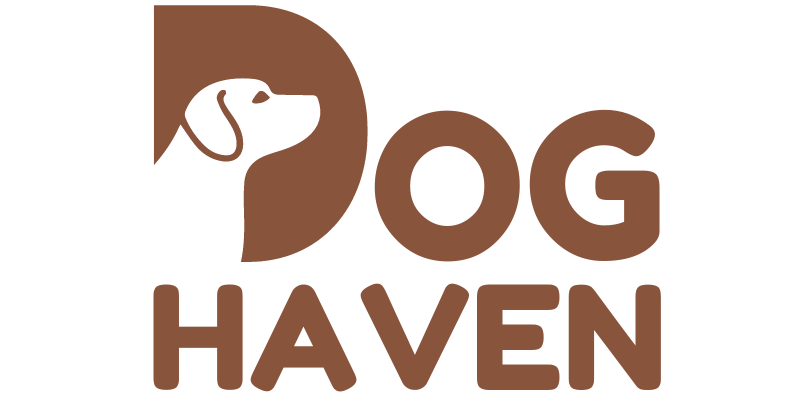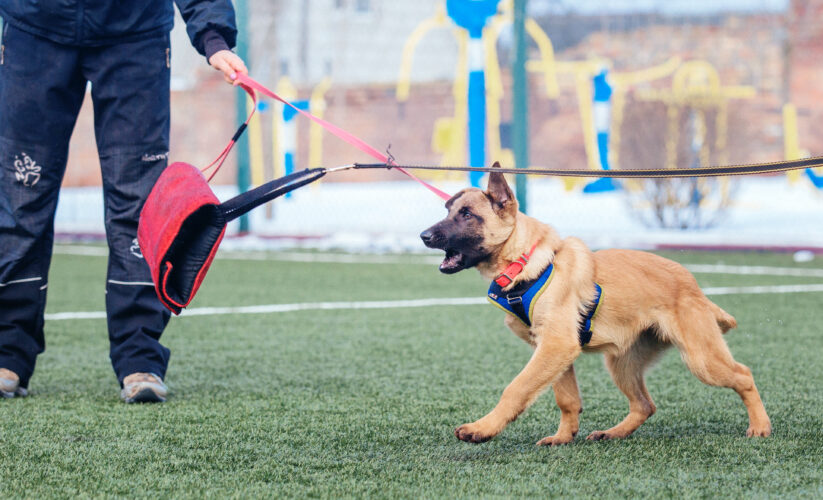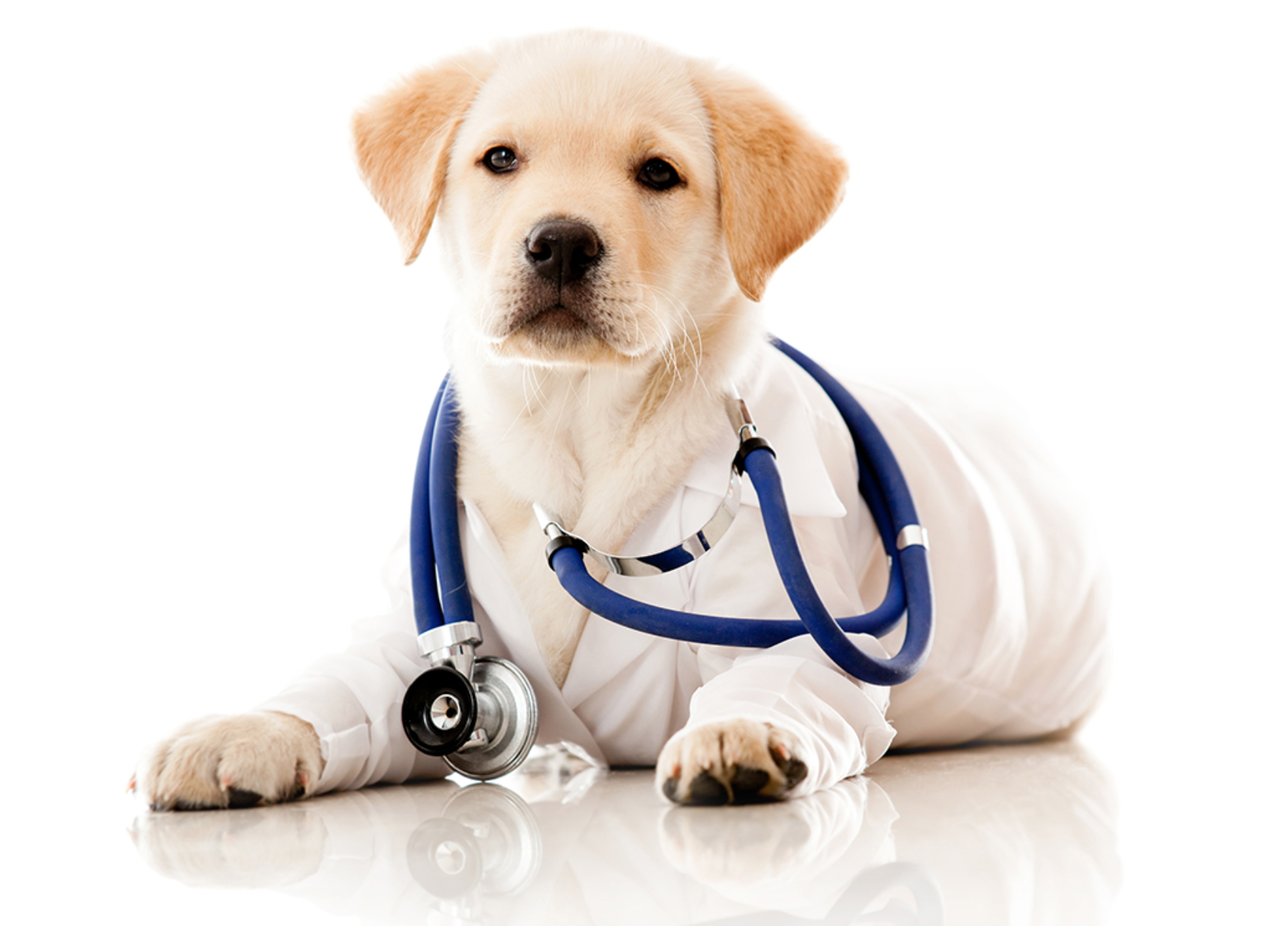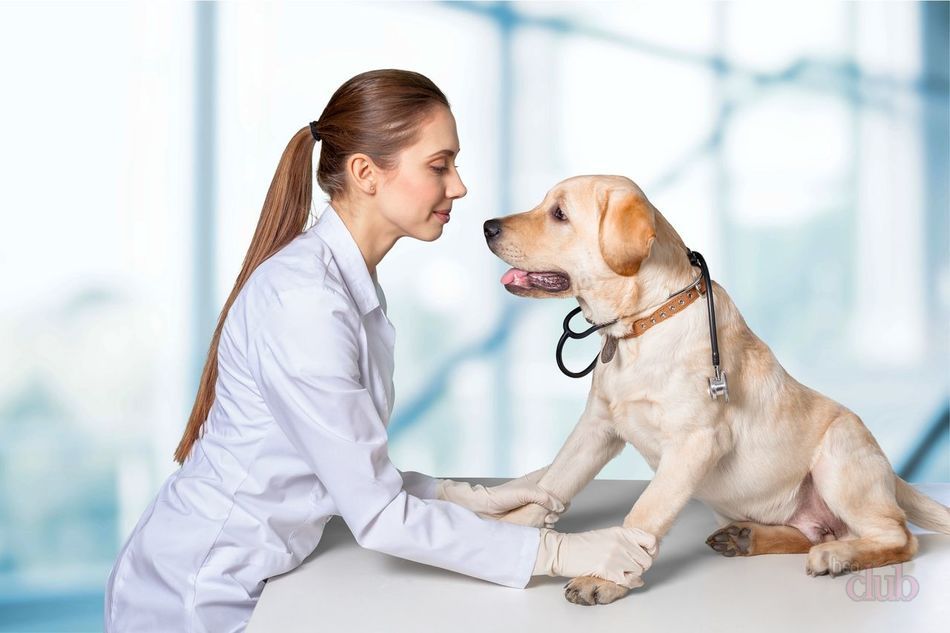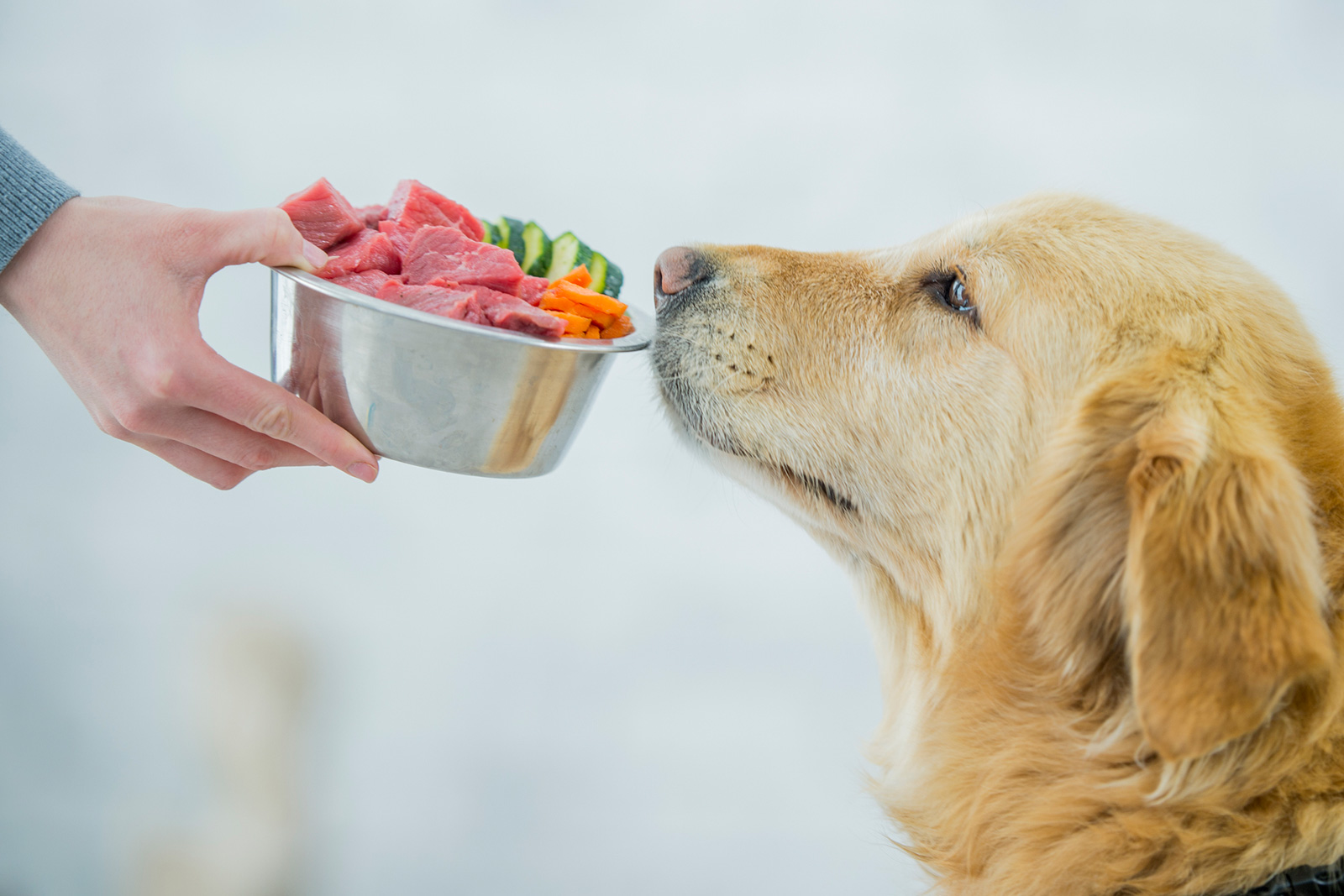
The Best Diet for Your Dog: What You Need to Know
Ever thought the kibble you give your dog could be key to their health? It might seem like just food, but it’s crucial for their well-being. Finding the best diet for your dog can be tough, but it’s essential. Dogs, like their wild ancestors, are omnivores but need a balanced diet.
Understanding what your dog needs for good health means looking at their evolution. Dogs have changed but still need a diet rich in proteins and fats. Yet, they can also digest carbohydrates well, including cooked grains. Treats and human food should be given in moderation, making up no more than 15% of their daily calories.
Different dogs have different needs based on their breed, age, and health. A diet good for an active dog might not be right for a small, less active one. Conditions like pancreatitis require special diets. Homemade diets can lack important nutrients like calcium, so it’s best to use vet-recommended foods or consult a nutritionist.
When changing your dog’s diet, do it slowly, starting with 75% of the old food and 25% of the new. This helps prevent digestive issues. Knowing the right amount of food to feed your dog is also key to avoiding weight problems or giving them too little energy.
For a spayed or neutered adult dog that stays indoors, a simple formula can help estimate their daily calories. It’s 30 x their weight in kilograms plus 70.
As we debunk myths about healthy dog nutrition, our main goal is to strengthen the bond with your pet through good health. It’s about showing love through the food you give them.
Understanding Your Dog’s Nutritional Needs
Ensuring our dogs’ health and longevity starts with knowing their nutritional needs. Canine dietary needs change with age, from puppyhood to senior years. A balanced dog diet is key, with the right mix of water, proteins, fats, carbs, vitamins, and minerals.
Puppies need more protein to grow fast. The AAFCO says they should get at least 22% protein on a dry matter basis. Adult dogs need 18% for upkeep. But, don’t give them more than 30% protein to avoid health issues.
Customizing diets for dogs with health issues is important. Dogs with kidney disease or allergies might need less protein to keep their bodies balanced. Most dogs don’t have food allergies, but finding and avoiding dietary triggers is key.
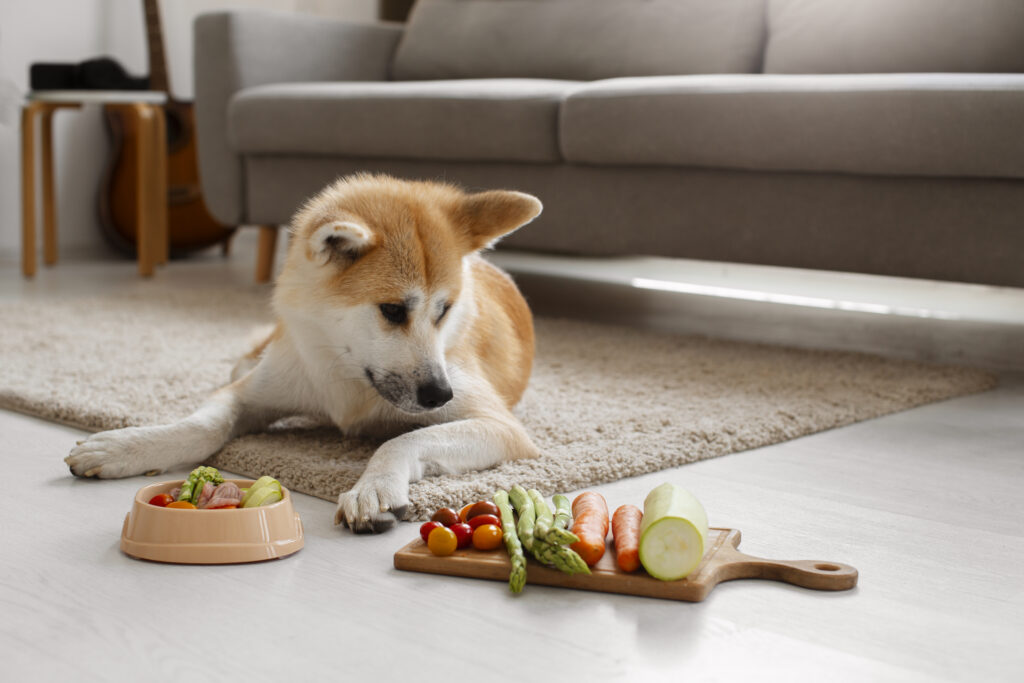
Fats like Omega-3 and Omega-6 are vital for healthy skin and fur. Dogs can’t make these fats on their own. Carbs give them energy and are easy for them to digest.
Feeding habits matter for a balanced dog diet. Adult dogs do well with one or two meals a day. Treats should make up no more than 10% of their daily calories to avoid obesity and health problems.
To sum up, a good diet for dogs means tailoring it to their life stages. Following vet advice and providing all the needed nutrients keeps our dogs healthy and full of life.
Choosing the Right Dog Food: Quality Over Quantity
Choosing high-quality dog food can be tough with so many options. But, it’s key to pick quality over quantity for your pet’s health. It’s not just about the protein amount, but where it comes from and how easy it is for your dog to digest.
Looking at the ingredient list is important. Fresh meat might be first but loses water during processing, changing the nutrition amount. This detail is key to knowing what you’re feeding your pet.

Labels often use “minimum” and “maximum” for nutrients. Knowing the difference is crucial for right feeding. Also, choosing foods with whole-food ingredients is better for your pet’s health and life span.
For less active dogs, a low-calorie diet is best to avoid weight gain. This keeps them at a healthy weight, preventing obesity-related health issues. Creating a balanced diet plan is key for your dog’s health and long life.
Talking to a vet is the best way to pick the right dog food guide for pets with special needs. Vets give advice based on your dog’s health, breed, and age. They offer insights that go beyond what’s on food labels.
In conclusion, choosing the best dog food means your pet gets more than just food. With the right advice and knowledge, every meal can make your pet happier and healthier.
The Best Diet for Your Dog: Customizing Nutrition for Your Pet
Dog dietary customization is key to keeping your pet healthy. It means tailoring their diet to their breed, metabolism, and lifestyle. Switching to vegetarian or vegan diets needs careful planning and expert advice to ensure your dog gets all the nutrients they need.
Feeding your pet right is more than picking the best commercial food. It means choosing products that meet the AAFCO standards for being complete and balanced. This is vital for big breed puppies, which need a balanced diet until they are 18 months old. Giant breeds may need it until they are 24 months old. Changing their diet every few months can help prevent health issues and keep their stomach healthy. But, make these changes slowly to avoid upsetting your dog.
Choosing home-prepared meals or raw meat diets requires following vet-approved recipes to avoid nutritional problems. Any raw ingredients should be used within 48 hours for safety. Don’t start a grain-free diet without a vet’s advice, as it could lead to health problems like heart issues. Make sure any diet, especially raw food diets, is balanced for your dog’s age and health.
Keeping your dog’s diet consistent helps their digestion and health. But, too many treats or the wrong supplements can upset their diet balance. To support healthy dog nutrition, include proteins, vitamins, minerals, and carbs. Working with a vet or nutritionist can help create a dog dietary customization plan and track its effects on your dog’s health.
Feeding Practices: Portion Sizes and Frequency
Having a dog feeding schedule is key for a balanced dog diet and good health. Most adult dogs do well with two meals a day, about 12 hours apart. This can change based on the dog’s age, health, and how active they are. Puppies need around 3 to 4 meals a day to support their fast growth and development.
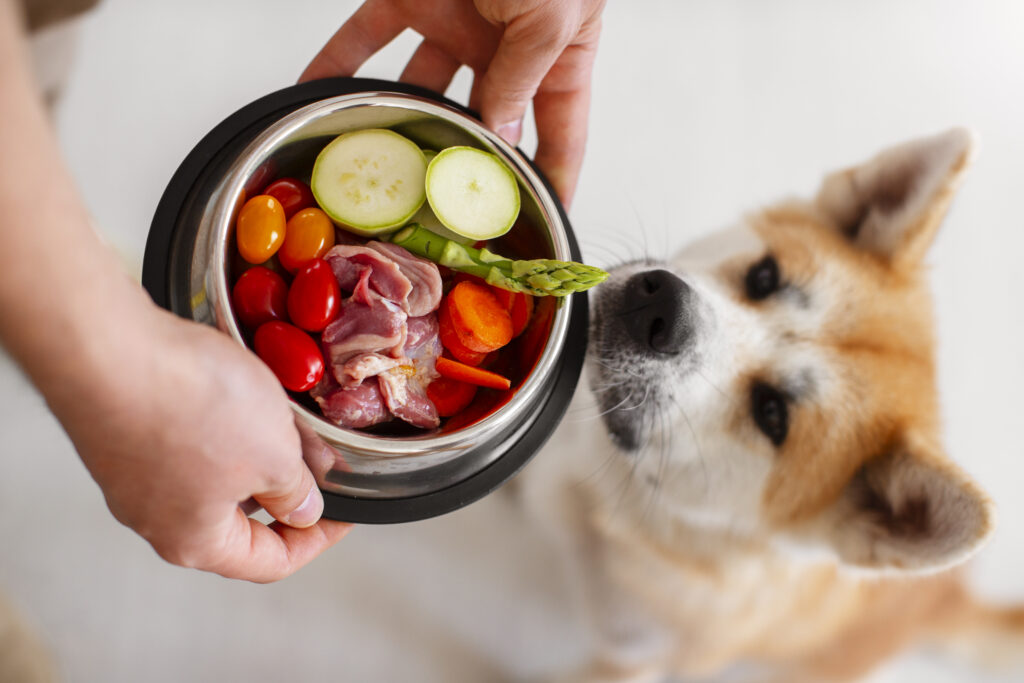
Eating too much at once can cause health problems like bloating and stomach pain. On the other hand, regular feedings help the body get ready for digestion. A steady feeding routine also helps dogs adjust to changes at home, like new pets or moving.
Feeding frequency should also be adjusted according to the dog’s life stages. Senior dogs might need smaller, more frequent meals because of slower metabolisms or health issues. It’s best to talk to a vet to make sure the feeding schedule and portions are right for your dog’s weight, health, and energy needs.
It’s very important to watch and adjust your dog’s feeding plan. A steady and balanced diet helps avoid weight problems and supports a healthy metabolism. This leads to a longer and better life for your dog.
Common Dog Diet Myths Debunked
In the world of dog health and nutrition, many believe dogs need only raw diets. But, this idea lacks solid science. Dogs can eat both raw and cooked foods and get the nutrients they need for good health. Feeding dogs mostly raw meat can be risky, though, as it may carry harmful bacteria like antibiotic-resistant E. coli.
Some think all commercial dog foods are bad for dogs. This is not true. Quality commercial foods are made to fit dogs’ nutritional needs and follow strict rules. Look for foods labeled by the Association of American Feed Control Officials (AAFCO) to make sure they’re good.
Many believe dogs can’t handle grains and that grain-free diets are best. But, most dogs can eat grains without a problem unless they’re allergic. Grain-free diets might even be linked to heart problems in dogs. Grains often add important nutrients missing in grain-free foods.
It’s also a myth that more protein is always good for dogs. Proteins are crucial, but too much can harm dogs with kidney issues. Adjust protein levels based on your dog’s health and age. Homemade diets can be unbalanced and lack the right adjustments.
Words like “holistic,” “primal,” and “all-natural” on dog food labels might sound good, but they mean nothing official. Don’t be fooled by these terms. Always check the real nutritional facts. Talking to a vet for advice on dog health and nutrition is the best way to make sure your pet eats right.
Special Considerations for Different Breeds and Life Stages
Understanding the balance of a breed-specific dog diet and life-stage dog nutrition is key for canine health. Dogs differ in size, metabolism, and health needs, requiring specific diets. Their nutritional needs change from puppyhood to adulthood and senior years.
Puppies need diets high in protein and fat for their fast growth and energy. Small breeds may switch to adult food sooner than big breeds because they grow faster. Senior dogs, no matter the breed, might need more omega-3 fatty acids and glucosamine for joint and organ health.
The size and activity level of a dog affect their diet. Active breeds like working or sporting dogs need food rich in protein and fat for their busy lives. Smaller breeds, however, need more calories but in smaller amounts to avoid obesity.
Some breeds face health issues that diets can help with. Large breeds, for example, benefit from foods with glucosamine and chondroitin for joint health. These nutrients help prevent hip dysplasia and arthritis, common in large dogs as they age.
Owners should work with vets to find the right life-stage dog nutrition for their breed. This ensures diets are effective and right, supporting a long, healthy life. It’s about feeding right at every stage for the best health.
Keeping Your Dog Healthy: Avoiding Dangerous Foods
When it comes to dog health hazards, it’s crucial to feed them right and avoid harmful foods. Some foods safe for humans can be bad for dogs. For example, tinned fish can have bones that can hurt your dog’s stomach. Also, veggies like cooked pumpkin or raw carrot are good for their bowels, but don’t overfeed them.
Keeping your dog’s food safe means avoiding toxic foods too. Foods like chocolate, garlic, and onions can make dogs very sick. Dogs like meat, but some foods like raw yeast dough and fatty cuts are dangerous. These can cause stomach problems or pancreatitis.
Small and medium dogs grow up by 12 months, and big ones by 18-24 months. After that, they need different food. It’s important to watch how much salt they eat, especially if they have health issues.
Learning about dog food helps prevent vet visits and lowers pet insurance claims. The ultimate guide to preventing common dog diseases is a great resource for owners. Knowing the dangers of foods like chocolate and sugar-free products can help keep your dog safe and healthy. If your dog eats something bad and shows signs like vomiting or seizures, get vet help right away.
